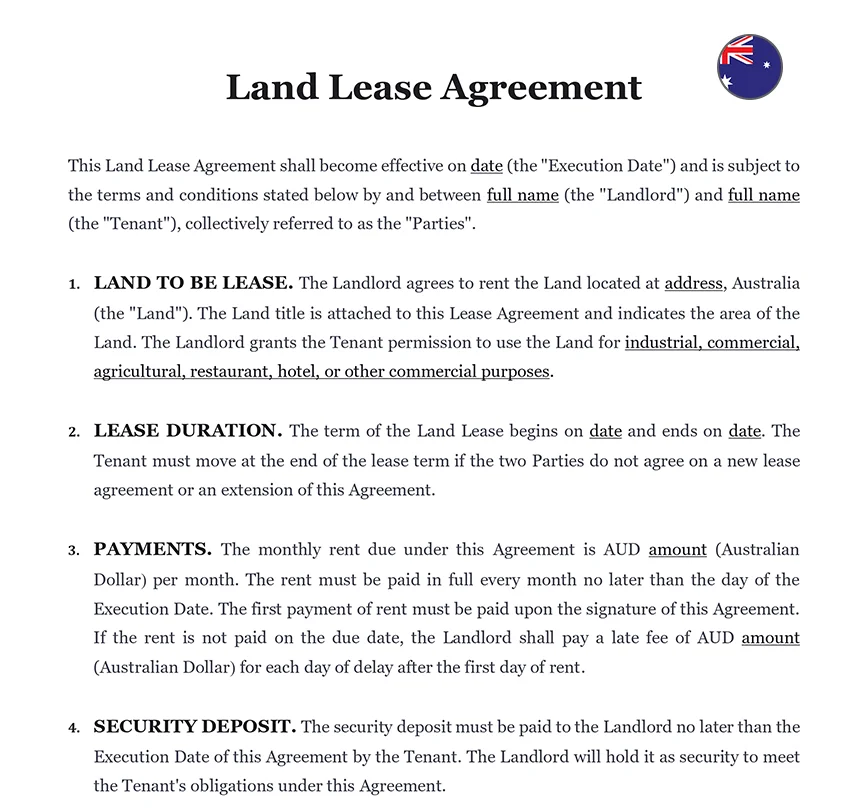Why Ground Leases Matter for Investors
Ground leases play a significant role in the Australian real estate market, providing both investors and landowners with strategic advantages. These long-term agreements allow tenants to use land owned by another party, typically for 30 to 99 years. By grasping the concept of ground leases, investors can leverage these agreements to achieve stability and long-term gains.
Understanding Ground Leases
Ground leases are a specialized form of lease agreement where the tenant has the right to use and develop the land but does not own it. Unlike standard lease agreements, ground leases are long-term, often spanning several decades. The tenant may construct buildings or make improvements on the land, which remain the property of the tenant during the lease term but revert to the landowner once the lease expires. This arrangement benefits both parties: landowners receive stable rental income without selling their property, and tenants gain access to valuable land for development.
Types of Ground Leases in Australia
Australia’s diverse real estate market features various types of ground leases, each tailored to specific needs and sectors:
| ➤ Residential Ground Leases: Although less common, residential ground leases offer stability for long-term living arrangements. They can be ideal for investors looking to provide housing while retaining land ownership. |
| ➤ Commercial Ground Leases: These leases are prevalent in the commercial real estate sector, encompassing office buildings, retail spaces, and other business properties. Commercial ground leases often involve more complex terms and conditions, reflecting the higher value of the properties involved. |
| ➤ Industrial Ground Leases: Tailored for industrial properties, these leases accommodate the extensive modifications and use required for manufacturing and logistics operations. Industrial ground leases typically include provisions for significant development and maintenance responsibilities. |
Benefits of Ground Leases for Investors
Investors in Australian ground leases can enjoy several advantages:
1. Predictable Income: Ground leases provide a reliable and consistent income stream through fixed rent payments. These payments are often adjusted periodically based on inflation or market conditions, ensuring a stable financial return.
2. Reduced Risk: By retaining land ownership, investors reduce their risk exposure. The lease agreement specifies the terms of land use, minimizing uncertainties related to property value fluctuations or tenant activities.
3. Long-Term Security: Ground leases often extend for several decades, offering long-term security and stability. This extended term allows investors to plan for the future and build lasting relationships with tenants.
Key Considerations When Entering a Ground Lease
When entering a ground lease agreement, investors should carefully consider several factors to ensure the lease aligns with their investment goals:
1. Lease Term: The length of the lease is a critical factor. Longer leases provide stability and security, while shorter leases may offer more flexibility but less long-term certainty. Assess how the lease term aligns with your investment strategy and goals.
2. Rent Structure: Understanding the rent structure is essential for evaluating the lease’s financial impact. Some leases feature fixed rent, while others include escalation clauses that adjust payments based on inflation or market conditions. Evaluate how these structures will affect your cash flow and returns.
3. Maintenance and Improvements: Clarify responsibilities for maintaining the property and making improvements. Some leases require tenants to handle all maintenance and upgrades, while others may have shared responsibilities. Understanding these terms will help you assess the overall cost and potential return on investment.
ℹ️ By using the Rental Application you can avoid Common mistakes in a land lease agreement.
Legal Aspects of Ground Leases
Ground leases involve various legal considerations, which are crucial for protecting both parties’ interests:
| ➤ Lease Agreements: A comprehensive and clear lease agreement is essential. It should outline the rights and obligations of both the landowner and the tenant, including details on rent payments, maintenance responsibilities, and dispute resolution mechanisms. |
| ➤ Dispute Resolution: Include provisions for resolving disputes that may arise during the lease term. This can involve mediation, arbitration, or other mechanisms to ensure any issues are addressed efficiently and fairly. |
| ➤ Regulatory Compliance: Ensure the lease complies with local regulations and zoning laws. This includes adhering to land use regulations, environmental standards, and other legal requirements that may affect the lease's validity and implementation. |
How to Negotiate a Ground Lease
Effective negotiation is key to securing favorable terms in a ground lease agreement. Here are some strategies to consider:
1. Research Market Rates: Before negotiating, research current market rates for similar leases to ensure you are getting a fair deal. Understanding prevailing rates and terms will help you negotiate from a position of strength.
2. Consult Professionals: Engage legal and financial advisors to review and negotiate lease terms. Professionals can provide valuable insights and help you avoid common pitfalls, ensuring that the lease agreement meets your needs and protects your interests.
3. Prioritize Key Terms: Focus on crucial terms such as lease duration, rent increases, and maintenance responsibilities. Ensure these terms align with your investment goals and financial projections.
Common Pitfalls to Avoid
Investors should be aware of potential pitfalls when dealing with ground leases, including the necessity to thoroughly review lease terms to avoid unfavorable conditions, stay informed about market trends to prevent overpaying, and seek proper legal advice to ensure the lease agreement is comprehensive and compliant.
Comparing Ground Leases with Other Lease Types
To fully understand the value of ground leases, it’s helpful to compare them with other types of leases:
1. Standard Leases: Unlike ground leases, standard leases are typically shorter in duration and involve renting both land and any existing structures. Ground leases offer longer terms and focus solely on land use, providing different strategic benefits.
2. Net Leases: In net leases, tenants pay additional costs such as property taxes, insurance, and maintenance. Ground leases often have different cost structures, which can affect the overall financial implications for both parties.
3. Triple Net Leases: These leases are a type of net lease where tenants cover all property-related expenses, including maintenance and repairs. Ground leases may involve different responsibilities and cost-sharing arrangements.
Evaluating the Future of Ground Leases
As the real estate market evolves, ground leases are likely to continue playing a significant role in property investment strategies. Factors such as urban development, changes in zoning laws, and shifts in market demand can impact the future landscape of ground leases. Staying informed about these trends will help investors adapt and optimize their strategies.
Ask your question and receive legal advice from a qualified lawyer
310 client reviews (4.8/5) ⭐⭐⭐⭐⭐











